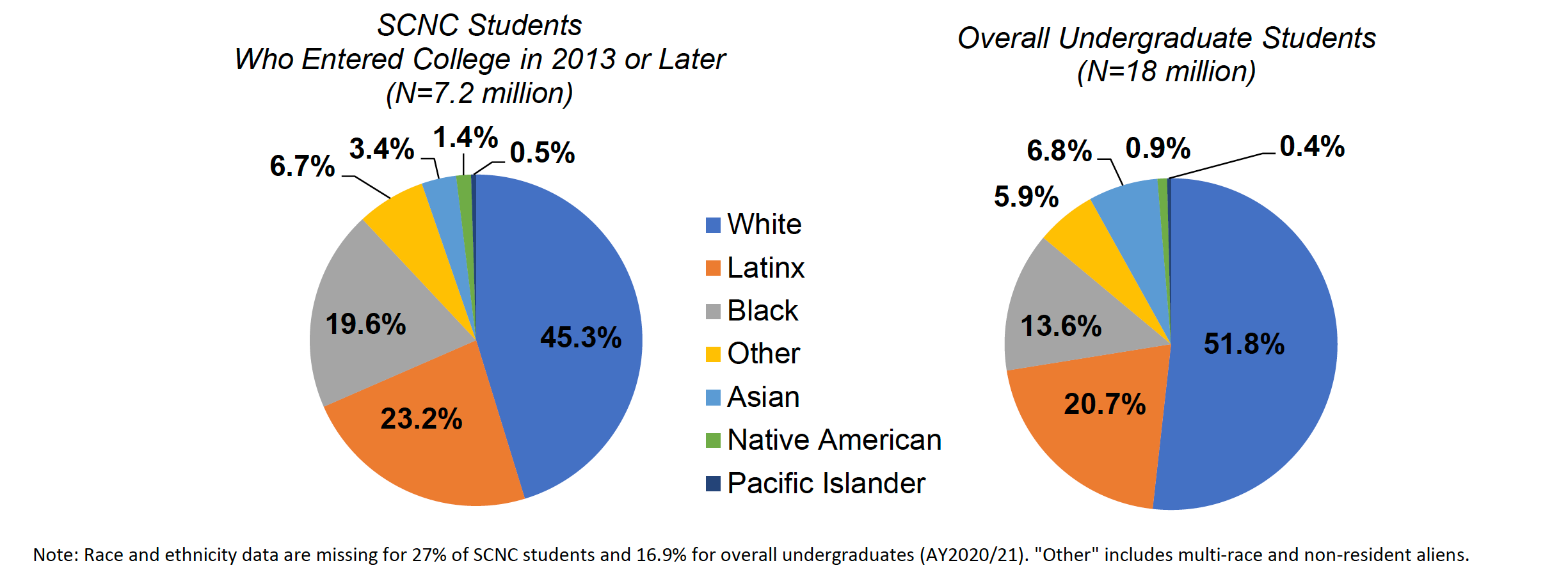- BLOG HOME
- »
- Research Services
- »
- Panelists Discuss 39 Million Americans with Some College, No Credential

Panelists Discuss 39 Million Americans with Some College, No Credential
Education Leaders Provide Insight on Students Re-Enrolling and Finishing Their Degree
“Despite the COVID-19-led disruptions, over 944,000 students re-enrolled in postsecondary education, and more than 60,000 students obtained a credential the same year they returned,” remarked Mikyung Ryu, director of research publications at the National Student Clearinghouse Research Center. “An additional 532,000 students were still enrolled after enrolling the previous year. Once SCNC students re-enroll, they are likely to persist until they complete a first credential without stopping out again.”
The webinar, moderated by Courtney Brown, vice president for impact and planning at Lumina Foundation, included a panel discussion on how colleges and universities are working to re-enroll SCNC students. The panelists shared information on the pathways SCNC students take and how their institutions are helping those students succeed in earning a college credential.
“These fresh insights, along with other major new reports, provide a blueprint for educators, employers, policymakers, and community leaders on how to move forward,” said Brown. “We know what to do. It’s time to reverse this trend, get these forgotten students back on track — and help millions complete a valuable degree or certificate.”
Patricia Steele, founder and principal of Higher Ed Insight, spoke on new research on SCNC students who successfully re-enrolled and completed a credential. “A large portion of these folks had not only completed credentials, but they’d also completed more than one credential in some cases. I think this is unexpected because many people look at this population, and they see stop-outs or drops-outs, but in reality…this was a story about perseverance for these students.”
Steele continued, “I think we have to extend the timeframe that we give students to succeed when we think about outcomes [and] think radically about how to make the process easier for students. That is really where the conversation has to begin.”
At Morgan State University, a historically black university, a new program has been implemented to engage the SCNC population. The Applied Liberal Studies program, introduced five years ago, was developed to encourage nontraditional students to return to school and earn their degrees. As a result of the program’s success, Morgan State created eight undergraduate, five masters, and five PhD programs for students who have stopped out.
“What’s really unique about the programs we designed is that they’re interdisciplinary, they’re meeting some high needs within the employment industry, and they’re not necessarily modifications of currently existing programs,” said panelist Nick Vaught, assistant dean for academics and student’s success in the College of Interdisciplinary and Continuing Studies at Morgan State University. “Our goal is to help students finish their degree, not start over.”
Panelist Patty Erjavec, president of Pueblo Community College in Pueblo, Colorado, discussed the success of her college’s Return to Learn program, which provides a financial incentive for SCNC students who return and complete one semester. “We knew that if we were going to get these students across the finish line, we needed to pay attention to the reasons that they dropped out to begin with,” said Erjavec. “That one-on-one unique attention to each student is what we believe helped build the program to where it is. Our success rate with the program is 87 percent.”
The SCNC report includes a state-by-state dashboard with key information about SCNC student profiles, such as demographic and enrollment characteristics. Of note, 48 states and D.C. experienced a net growth of SCNC student numbers, with California, Texas, New York, and Illinois accounting for more than a third of the nation’s SCNC students. In addition, Black, Latinx, and Native American learners were over-represented in the SCNC population.
The Clearinghouse also introduced three new metrics for tracking SCNC student outcomes: “Re-Enrollment” after stop-out; completion of “First Credential;” and “Perseverance” as indicated by continuous enrollment beyond first re-enrollment. The outcomes were reported during the 2020-21 academic year, both for the nation and by state, with details on student subgroups categorized by gender, age, and race/ethnicity.
View the webinar, “Some College, No Credential Student Outcomes,” to learn more about the report’s findings and how you can successfully engage SCNC students.
A National Snapshot of the SCNC Racial/Ethnic Composition

“These fresh insights, along with other major new reports, provide a blueprint for educators, employers, policymakers, and community leaders on how to move forward.”
Courtney Brown
Vice President for Impact and Planning, Lumina Foundation
Additional Resources:



